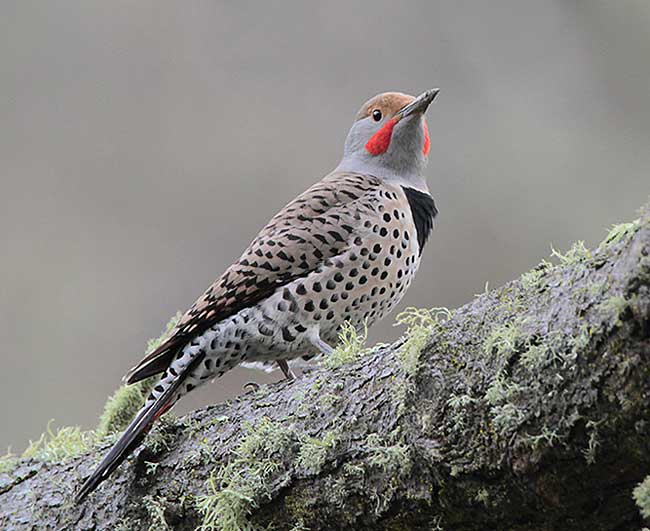
Alabama is a medium-sized state with a area of 52,419 square miles, and a population of 5 million. This mosaic of habitats is typical for much of Alabama although there are some low mountains with Appalachian forests in the north, and coastal habitats around Mobile.
Another typical aspect of Alabama state bird – the Northern Flicker. It is so common and wildly recognized that for many, Alabama is known as the Yellowhammer state. This nickname comes directly from their flicker populations, which are also called Yellow-shafted Flicers.
On this page
History of Alabama State Bird
The Northern Flicker (Colaptes auratus) became the state bird of Alabama in 1927, one year after Kentucky became the first state to recognize the Northern Cardinal as their official state bird.
As with the naming of many other state birds, this was associated with campaigns during the 1920s. It was carried out by the General Federation of Women’s Clubs to have every state vote on and choose a bird that best represents the state.
The choice for Alabama turned out to be an easy one. Although this southern state is home to many bird species, the Northern Flicker was the obvious choice because most Alabamans had identified with the “Yellowhammer” since the Civil War era.
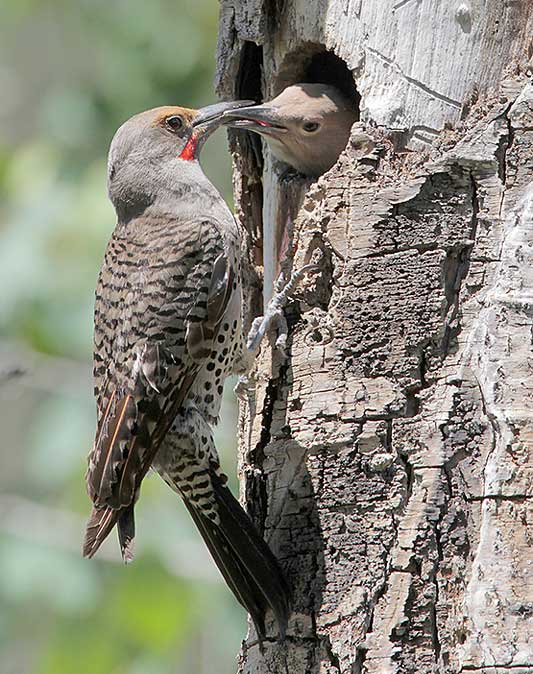
Northern Flickers at their nest
As the story goes, in 1862, the largest city in Alabama, Huntsville, had sent a regiment of soldiers to fight in Kentucky. Unlike the worn uniforms of the soldiers already present, the regiment from Huntsville wore fresh uniforms trimmed with bright yellow cloth.
In any case, this caught the attention of the other soldiers, one of whom made a joke that they looked like “Yellowhammers.” Since he supposedly yelled, “Yellowhammer, Yellowhammer, flicker, flicker!” the association with the common woodpecker species was undeniable.
That company of soldiers decided to call themselves the “Yellowhammer Company“, the nickname stuck, and subsequent troops from Alabama continued to decorate their uniforms with bits of yellow cloth, some also putting a yellow feather in their caps.
Since then, the Northern Flicker or “Yellow-hammer” has been an important symbol for Alabama and continues to be a commonly seen bird in every part of the state.
Fun Facts about The Northern Flicker
- Although the eastern subspecies of the Northern Flicker is often called a “Yellowhammer”, this is actually the official name of a common bunting species from western Europe.
- The Northern Flicker is the only member of the woodpecker family in North America that often feeds on the ground. It does this to forage for one of its favorite food items; ants.
- Their diet doesn’t stop with ants, though – Northern Flickers eat other insects, too; they won’t say no to grasshoppers, caterpillars, termites, spiders, and berries and fruit.
- Northern Flickers that live west of the Rocky Mountains have reddish coloring under their wings and in the tail, and not the bright yellow of the “Yellowhammer”. Hybrids of these two types of Northern Flickers occur in the Great Plains just east of the Rocky Mountains.
- The Northern Flicker has had many other common names in addition to “Yellowhammer,” including Common Flicker, Gaffer Woodpecker, Harry-wicket, the Heigh-ho, the Yarrup, and the Gawker Bird.
- The Northern Flicker is the only Woodpecker species in the United States colored in different shades of brown. These earthy hues with black spots help camouflage the Flicker as it forages on the ground.
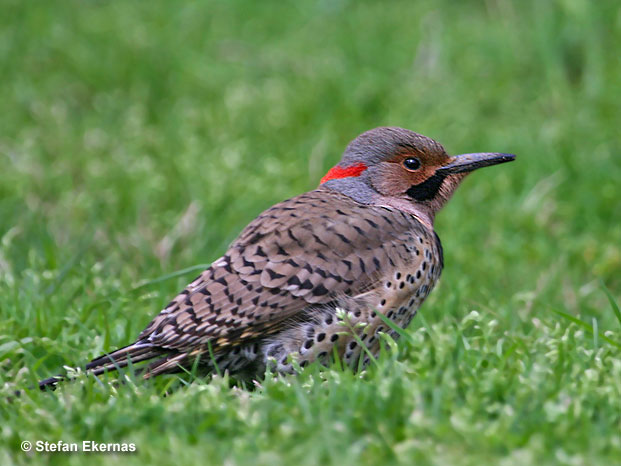
The Northern Flicker is the only Woodpecker species in North America that often feeds on the ground
Identification
The Northern Flicker is a large, foot long Woodpecker with a wingspan of 20 inches, and a fairly long and thick black bill. Males are a little bit larger than females and weigh 139 grams while females weigh 131 grams.
Although there are a few different subspecies that have some differences, all Northern Flickers have long, rounded wings, an olive-brown back and upperwings with black barring, white on the lower back and rump, and a fairly long and pointed tail that is black above and has a thick black tip below. They also have a large black patch on the chest and small black spotting on white or pale tan underparts.
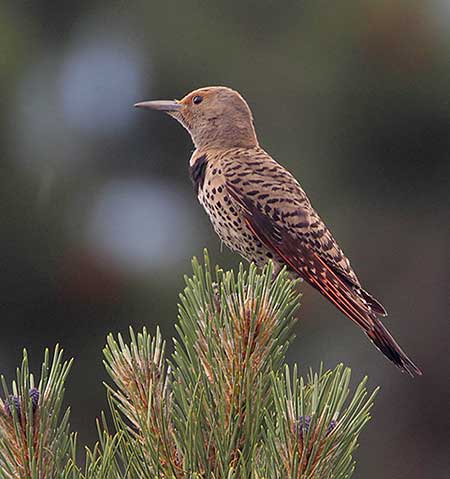
Female Northern Flicker
The “Yellow-shafted” Flicker occurs east of the Great Plains and both sexes have bright yellow on the underwing and under the tail, a gray crown and nape with a red patch on the back of the head, and a tan face and throat.
The male also has a strong black mustache or malar stripe. “Red-shafted” Flickers live west of the Rocky Mountains and have reddish on the underwing and under the tail.
They also differ by having a pale gray head and throat with some tan coloring above and near the eye and bill, and lack the red patch on the back of the head. Instead, the male Red-shafted Flicker has a red mustache or malar stripe.
Related: Bird names that start with N
Hybrid Yellow-shafted and Red-shafted Flickers occurring in the Great Plains just east of the Rocky Mountains usually have heads that resemble Yellow-shafted Flickers but have red-orange or pinkish on the underwings and under the tail.
Call
The Northern Flicker is a very vocal bird with distinctive calls. One of the most common calls sounds like “flicka-flicka-flicka”; a vocalization that acted as inspiration for its common name of “Flicker”.
This call is made in many situations, often while perched, when confronting other Flickers, and in flight. A loud, one-noted “Peear!” call is also frequently heard, mostly during the nesting season.
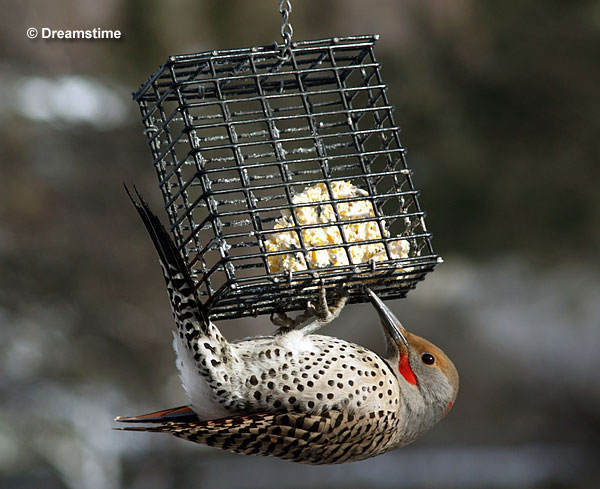
All of these calls are distinctive but one of the Northern Flicker’s other vocalizations is a repetitive series of sharp, loud, laughing “kek” notes that can sound a lot like a Pileated Woodpecker. This long call is loud, often heard in spring, and differs from that of the Pileated Woodpecker by being higher and faster.
Like other Woodpeckers, the Northern Flicker also makes drumming sounds by rapidly tapping its bill on dead wood or another suitable surface. Is usually drums in conjunction with making the loud laughing call to delineate territory.
The Behavior of Alabama State Bird
Northern Flickers can occur alone or in pairs, and since they prefer semi-open areas, they are often seen in flight as they move from one foraging area to the next. This Woodpecker species is also frequently seen on the ground, where it spends much of its time foraging for ants.
The Northern Flicker is not very aggressive with other bird species although some will drive off bluebirds and other species they compete with for nesting holes. They are more aggressive with their own kind, mostly when defending territories.
To defend their territory a Flicker will call and drum as well as face off with the intruder where the birds flick their wings open as they perch in front of each other. If one of the birds does not fly away, they can peck and claw at each other.
Various hawk species are the main predators of adult Northern Flickers while nestlings are attacked by squirrels, weasels, crows, jays, and snakes. They aren’t very afraid of or aggressive around people.
Other Common Birds in Alabama
I’m sure you’ve seen plenty of other birds flying around or singing from high perches. Alabama has a quite rich bird population – there are songbirds, different woodpeckers, owls, ducks, and even hawks.
Here are some of the most common birds you can see in Alabama:
- Northern Cardinals
- Carolina Wrens
- Blue Jays
- Northern Mockingbirds
- Mourning Doves
- Tufted Titmice
- Carolina Chickadees
- Red-bellied Woodpeckers
Interested in more? 35 Most Common Birds of Alabama
People Also Ask
What is the state bird of Alabama?
The state bird of Alabama is the Northern Flicker, also known as the Yellowhammer.
Why is the Northern Flicker the state bird of Alabama?
The Northern Flicker was chosen as the state bird of Alabama because during the Civil War, Alabama soldiers wore gray uniforms with yellow trimmings, earning them the nickname “Yellowhammers.” The Northern Flicker, with its yellow underwings and markings, resembles the soldiers’ uniforms, hence the association with Alabama and the selection as the state bird.
When did Alabama choose its state bird?
Alabama officially designated the Northern Flicker as its state bird in 1927.
What other states have the Northern Flicker as their state bird?
The Northern Flicker, or Yellowhammer, is not recognized as the state bird of any other states. It holds special significance in Alabama as a representation of its history and pride.
Does Alabama have an official state game bird?
Alabama’s state game bird is the Wild Turkey (Eastern Wild Turkey).
What other state symbols does Alabama have?
Alabama is known for its beautiful scenery, so of course, there are many symbols to admire. The most notable state symbols are the state flower (Camellia), state tree (Southern Longleaf Pine), state insect (Monarch Butterfly), and state mammal (American Black Bear).

